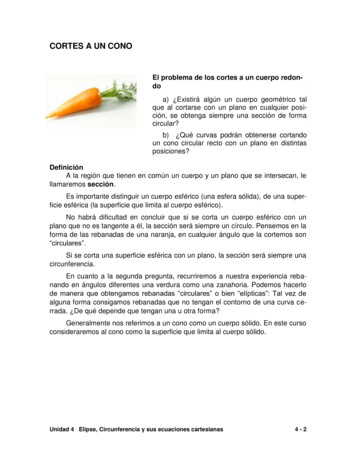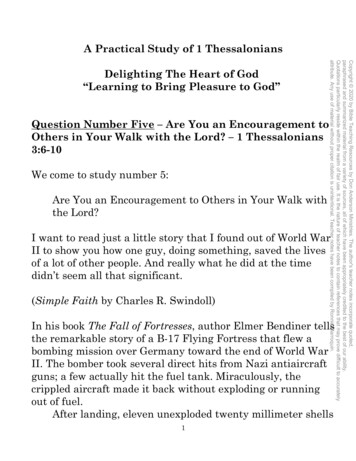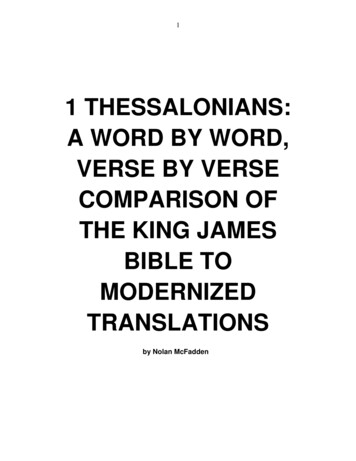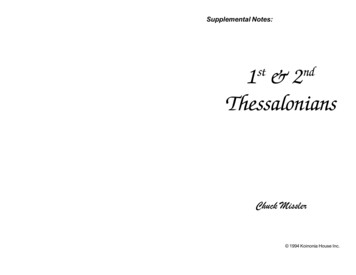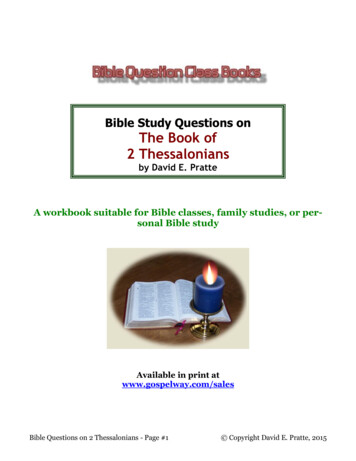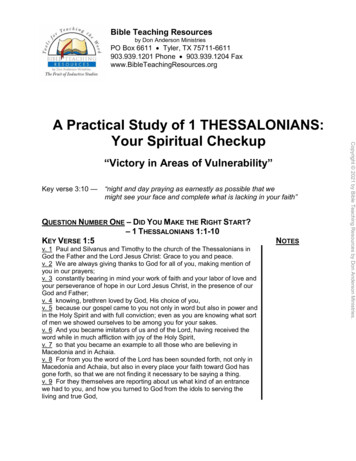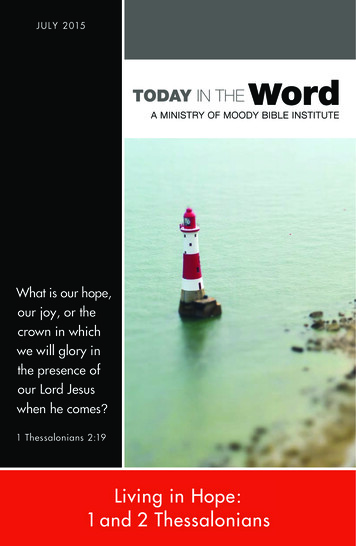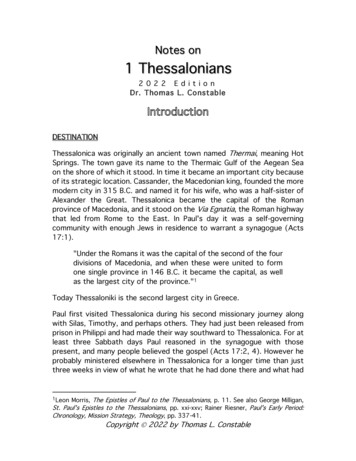
Transcription
Notes on1 Thessalonians2 0 2 2 E d i t i o nDr. Thomas L. ConstableDESTINATIONThessalonica was originally an ancient town named Thermai, meaning HotSprings. The town gave its name to the Thermaic Gulf of the Aegean Seaon the shore of which it stood. In time it became an important city becauseof its strategic location. Cassander, the Macedonian king, founded the moremodern city in 315 B.C. and named it for his wife, who was a half-sister ofAlexander the Great. Thessalonica became the capital of the Romanprovince of Macedonia, and it stood on the Via Egnatia, the Roman highwaythat led from Rome to the East. In Paul's day it was a self-governingcommunity with enough Jews in residence to warrant a synagogue (Acts17:1)."Under the Romans it was the capital of the second of the fourdivisions of Macedonia, and when these were united to formone single province in 146 B.C. it became the capital, as wellas the largest city of the province."1Today Thessaloniki is the second largest city in Greece.Paul first visited Thessalonica during his second missionary journey alongwith Silas, Timothy, and perhaps others. They had just been released fromprison in Philippi and had made their way southward to Thessalonica. For atleast three Sabbath days Paul reasoned in the synagogue with thosepresent, and many people believed the gospel (Acts 17:2, 4). However heprobably ministered elsewhere in Thessalonica for a longer time than justthree weeks in view of what he wrote that he had done there and what had1LeonMorris, The Epistles of Paul to the Thessalonians, p. 11. See also George Milligan,St. Paul's Epistles to the Thessalonians, pp. xxi-xxv; Rainer Riesner, Paul's Early Period:Chronology, Mission Strategy, Theology, pp. 337-41.Copyright Ó 2022 by Thomas L. Constable
2Dr. Constable's Notes on 1 Thessalonians2022 Editionhappened since he left (cf. Acts 17:4; 1 Thess. 1:8; 2:9; 2 Thess. 3:8; Phil.4:15-16).1"Probably as at Pisidian Antioch (Acts 13:46), at Corinth (Acts18:6, 7), and at Ephesus (Acts 19:8, 9), having preached theGospel to the Jews, when they rejected it, he turned to theGentiles."2Those who responded to the message of Christ's sufferings andresurrection (Acts 17:3) were Jews and God-fearing Gentile proselytes toJudaism (Acts 17:4). There were also some leading women of the city andmany idol-worshipping pagans (Acts 17:4-5).3"If Macedonia produced perhaps the most competent group ofmen the world had yet seen, the women were in all respectsthe men's counterparts; they played a large part in affairs,1SeeRobert L. Thomas, "1 Thessalonians," in Ephesians-Philemon, vol. 11 of TheExpositor's Bible Commentary, p. 230; Charles A. Wanamaker, The Epistles to theThessalonians, p. 7; Kenneth G. Hanna, From Gospels to Glory, pp. 313-14.2Robert Jamieson, A. R. Fausset, and David Brown, Commentary Practical and Explanatoryon the Whole Bible, p. 1329.3See Karl P. Donfried, "The Cults of Thessalonica and the Thessalonian Correspondence,"New Testament Studies 31:3 (July 1985):336-57, for more information on the religiousand political background of Thessalonica.
2022 EditionDr. Constable's Notes on 1 Thessalonians3received envoys and obtained concessions from them for theirhusbands, built temples, founded cities, engaged mercenaries,commanded armies, held fortresses, and acted on occasion asregents or even co-rulers."1When the unbelieving Jews heard of the conversion of the proselytes,whom the missionaries were discipling, they stirred up a gang of roughneckswho attacked the house of Jason (Acts 17:5). Paul and his friends had beenstaying with him. Unable to find the missionaries, the mob dragged Jasonbefore the magistrates who commanded him to keep the peace (Acts 17:69). Convinced of the danger to Paul and Jason, the Christians sent Paul andhis companions away from the city by night to Berea (Acts 17:10).Paul and his party began their evangelistic work in Berea in the synagogue,as was their custom. However when many Jews there believed the gospel,the Thessalonian Jews came down to Berea and stirred up more trouble(Acts 17:10-13)! At this point the Berean Christians sent Paul away toAthens, but Silas and Timothy remained in Berea (Acts 17:14). Then,having been sent for by Paul, Silas and Timothy joined Paul in Athens. ButPaul soon sent Silas back to Philippi and/or Berea, and he sent Timothyback to Thessalonica (1 Thess. 3:1-2; Acts 17:15). Later both menreturned to Paul while he was practicing his trade of tent-making in Corinth(Acts 18:3, 5; 1 Thess. 3:6). They came with a gift from the Christians inthose Macedonian towns (2 Cor. 11:8-9; cf. Phil. 4:15-16).DATEIt seems clear that Paul wrote this epistle shortly after he arrived in Corinth(1:7-9; 2:17; 3:1, 6; Acts 18:5, 11): about A.D. 51.2 If one follows theearly dating of Galatians before the Jerusalem Council (Acts 15), which Ido, this epistle would have been Paul's second inspired writing.3 If Paulpenned Galatians after the second missionary journey, 1 Thessalonians1W.W. Tarn and G. T. Griffith, Hellenistic Civilisation, pp. 98-99.Milligan, pp. xxxv-xxxvi.3See Richard C. H. Lenski, The Interpretation of St. Paul's Epistles to the Colossians, tothe Thessalonians, to Timothy, to Titus and to Philemon, pp. 212-13.2See
4Dr. Constable's Notes on 1 Thessalonians2022 Editioncould have been his first inspired epistle.1 However the first option seemsmore probable.2A few scholars have suggested that Paul wrote 2 Thessalonians before hewrote 1 Thessalonians.3 According to this theory 1 Thessalonians respondsto issues alluded to in 2 Thessalonians. This is not as improbable as mayappear at first, since the traditional sequence of Pauline letters to churchesrests on length rather than date. Nonetheless this theory has not convincedmost scholars.4OCCASIONTimothy's report of the conditions in the Thessalonian church was what ledPaul to write this epistle (1 Thess. 3:6-8). Some of the Thessaloniansapparently believed that Jesus Christ was about to return momentarily.They had consequently given up their jobs and become disorderly (cf. 4:11;5:14). Some worried about what had happened to their loved ones who haddied before the Lord had returned (4:13, 18). Persecution from theGentiles as well as the Jews still oppressed the believers (2:17—3:10) whowere nevertheless holding fast to the truth and eager to see Paul again(3:6-8). Some of those outside the church, however, remained hostile to1HenryAlford, The Greek Testament, 3:2:249; Arno C. Gaebelein, The Annotated Bible,4:1:90; J. Sidlow Baxter, Explore the Book, 6:213; Thomas, p. 248; Gordon D. Fee, TheFirst Epistle to the Corinthians, p. xi; A. T. Robertson, Word Pictures in the New Testament,4:3; J. S. Howson, in The Life and Epistles of St. Paul, p. 298; Milligan, pp. xxxvi-xxxviii;Harry A. Ironside, Addresses on the First and Second Epistles of Thessalonians, p. 9;Charles B. Williams, A Commentary on the Pauline Epistles, p. 16; J. Vernon McGee, Thruthe Bible with J. Vernon McGee, 5:367; John F. Walvoord, The Thessalonian Epistles, p.11; held that this was Paul's first epistle.2For a fuller discussion of which epistle was written first, see Thomas L. Constable, "1Thessalonians," in The Bible Knowledge Commentary: New Testament, pp. 687-89; andthe New Testament Introductions.3E.g., T. W. Manson, "St. Paul in Greece: The Letters to the Thessalonians," Bulletin of theJohn Rylands Library 35 (1952-53):438-46; ibid., Studies in the Gospels and Epistles; andWanamaker, pp. 37-45.4E.g., E. A. Best, A Commentary on the First and Second Epistles to the Thessalonians(1977 ed.), pp. 43-44; I. Howard Marshall, 1 and 2 Thessalonians, p. 26; R. Jewett, TheThessalonian Correspondence: Pauline Rhetoric and Millenarian Piety, pp. 24-25; Morris,pp. 27-30; and most others. See F. F. Bruce, 1 and 2 Thessalonians, pp. xxxix-xliv; orDonald A. Carson and Douglas J. Moo, An Introduction to the New Testament, pp. 54344; for good discussions of the issue.
2022 EditionDr. Constable's Notes on 1 Thessalonians5Paul (2:1-12). There appears to have been some misuse of spiritual gifts inthe assembly as well as an unfortunate tendency on the part of some toreturn to their former habits that involved sexual impurity (4:1-8; 5:1921).Paul had several co-workers who were Thessalonians during the course ofhis ministry: Aristarchus (Acts 20:4; 27:2 Col. 4:10; Phile. 24), Secundus(Acts 20:4), and Demas (Col. 4:14; Phile. 24; 2 Tim. 4:10) at least.In neither 1 Thessalonians nor 2 Thessalonians did Paul quote from the OldTestament.PURPOSEIn view of this epistle's contents Paul had at least eight purposes in mindwhen he wrote it: First, he wanted to express his thanks and praise for theThessalonian believers (1:2-10). Second, he wanted to encourage theChristians in Thessalonica who were making good progress in their new faith(2:1-16). Third, he wanted to defend himself against attacks by hisenemies, specifically his Jewish opponents (2:1-16). Fourth, He exhortedhis readers to stand firm in persecution and not to return to paganism(2:17—3:13). Fifth, he encouraged his readers to continue growing inChrist (4:1-12; 5:16-24). Sixth, he wanted to clarify the destiny ofChristians who die before the Lord's return (4:13-18). Seventh, he wantedto urge his readers to watch for the Lord to return (5:1-11). And eighth,he wanted to deal with certain aspect of church life (5:12-15).J. Vernon McGee saw a threefold purpose, which he put this way:"(1) To confirm young converts in the elementary truth of thegospel; (2) to condition them to go on unto holy living; and(3) to comfort them regarding the return of Christ."1Whereas we regard 1 and 2 Timothy and Titus as the Pastoral Epistles, 1and 2 Thessalonians are every bit as pastoral and personal as these letters,as is 2 Corinthians. They reveal much about "Paul's pastoral zeal and his1McGee,5:368.
Dr. Constable's Notes on 1 Thessalonians62022 Editionintense interest in the spiritual well-being of his converts."1 As such theyare an invaluable resource for people in pastoral ministry."Far and away the largest theological contribution of theEpistles [1 and 2 Thessalonians] lies in what they say abouteschatology [the study of last things]."2" over a quarter of 1 Thessalonians and nearly half of 2Thessalonians deal with problems and issues regarding theparousia or coming of Christ from heaven."3"The Thessalonian letters present the first literary evidence forthe use of parousia in the sense of the future Advent ofChrist: it occurs in this sense six times in the two letters. Theevent is depicted repeatedly in language borrowed fromportrayals of OT theophanies. But it is the ethical implicationsthat are chiefly stressed: the writers look forward to theParousia especially as the time when their service will bereviewed and rewarded by the Lord who commissioned them,and they will be content, they say, to have it assessed by thequality of their converts."4OUTLINE5I.II.Salutation and greeting 1:1Personal commendations and explanations 1:2—3:13A.Thanksgiving for the Thessalonians 1:2-101.2.B.Reminders for the Thessalonians 2:1-161.1Morris,Summary statement 1:2-3Specific reasons 1:4-10How the gospel was delivered 2:1-12p. 19.p. 233. Italics mine.3Wanamaker, p. 10.4Bruce, p. xxxviii.5For an outline of the book based on rhetorical analysis, see Wanamaker, p. 49.2Thomas,
2022 Edition2.C.How the gospel was received 2:13-16Desires to see them again 2:17—3:5Joy on hearing about them 3:6-13Practical instructions and exhortations 4:1—5:24A.Christian living 4:1-121.2.3.B.C.D.E.Continued growth 4:1-2Sexual purity 4:3-8Brotherly love 4:9-12The Rapture 4:13-18Personal watchfulness 5:1-11Church life 5:12-151.2.Attitudes toward leaders 5:12-13Relationships among themselves 5:14-15Individual behavior 5:16-241.2.3.IV.7Concerns for the Thessalonians 2:17—3:131.2.III.Dr. Constable's Notes on 1 ThessaloniansPersonal actions and attitudes 5:16-18Actions and attitudes in corporate living 5:19-22Divine enablement 5:23-24Conclusion 5:25-28MESSAGEIn this epistle there is evidence that Paul had conflicting emotions regardingthe new church in Thessalonica. On the one hand he was joyful and satisfiedwith what God had accomplished. On the other hand he felt concern aboutthe perils in which the new Christians lived.This letter differs from most of Paul's others in that it does not dealprimarily with a doctrinal issue or a departure in belief or behavior. Whilethe teaching on the Rapture of the church is definitely a doctrinalcontribution, Paul did not write primarily to expound that truth or to defendit. He was simply clarifying the events that he had previously taught them.
8Dr. Constable's Notes on 1 Thessalonians2022 EditionThis new revelation was, in a sense, secondary to Paul's argument.Nevertheless it is obvious that the Lord's return was prominent in Paul'smind from the beginning to the end of this letter. He referred to it in everychapter.Paul wrote this epistle primarily in order to comfort and to encourage thosewho were suffering for their Lord. Their hope was an essential emphasis inview of this purpose (cf. 1 Pet.). Both Thessalonian epistles are verypastoral. The epistle deals with the hope of the Lord's return as this relatesto Christian experience.Paul took the fact of the Lord's return for granted. He did not feelcompelled to try to prove it. The apostle's belief that Jesus would returnfor His own is obvious to anyone who reads this letter regardless of his orher eschatological convictions. Paul believed in a real return of the sameJesus who had lived on the earth, died, was buried, rose from the dead, andascended into heaven (cf. 4:16). First Thessalonians deals with when theLord will return, but the larger emphasis in 1 Thessalonians, however, isthat He will return.First, in relation to Christian experience the return of Christ is the finalargument that produces faith. When Paul preached the gospel inThessalonica he proclaimed that the Christ who had come to earth the firsttime would come again (1:9-10). His converts in this town were to wait forHim. They had turned from belief in visible idols to belief in an invisible God.Paul urged them to wait with the assurance that they would see their Godvisibly, and they might see Him soon. They turned from disorder to thehope of divine rule and from spiritual anarchy to the hope of an orderlykingdom.As Christians we believe in Christ's first coming, and we wait for His return.Without the hope of Christ's vindication the message of His death isincomplete. I do not mean to suggest that the return of Christ is part ofthe gospel message itself. However without the hope of Christ's return thegospel message is harder to accept. The return of Christ is the finalargument that produces faith in this sense. It is an apologetic (defense) forChristianity.Second, in relation to Christian experience the return of Christ is, second,the abiding confidence that inspires labor (1:9). The Thessalonians turnedfrom dead idols to serve the living God. Their reward for service would come
2022 EditionDr. Constable's Notes on 1 Thessalonians9at His return. That would be their payday. Paul referred to his readers ashis own reward for service at Christ's return (2:19-20). A little of theChristian's reward comes to us here and now, but the great bulk of it awaitsthe judgment seat of Christ (cf. 1 Cor. 15:58). When those we have led toChrist and discipled experience glorification our reward will be full. Thisprospect is what so forcefully motivated Paul in his tireless missionaryservice.Third, in relation to Christian experience, the return of Christ is the ultimatevictory that creates patience (3:13). The conviction that we will experienceultimate victory at the Rapture produces patience in the believer (cf.5:14b). We can be patient about our own slow growth, knowing thateventual glorification will take place. And we can be patient with God,knowing that He will balance the scales of justice and vindicate Himself.One day Christ will return, just as one day He was born. Both events aremomentous occurrences in history. They are high points, not built up togradually, but introduced as miraculous acts of God.Thus the return of Christ is the final argument that produces faith, theabiding confidence that inspires labor, and the ultimate victory that createspatience. In the introduction to this epistle Paul said that he rememberedhis readers' "work of faith and labor of love and perseverance of hope"(1:3).1 Faith, hope, and love are the three greatest characteristics of theChristian life (cf. 1 Cor. 13:13), and they are possible because Christ willreturn.This epistle also helps us to understand how we should respond to the truththat Christ shall return:First, in our own life we should respond with godly behavior, namely,personal purity, love for the brethren, and honesty in the world. Christ'sreturn should have a purifying effect in every one of these areas of ourlives (ch. 4).Second, in the face of death there is a twofold response: There is comfortfor the bereaved in particular (4:14). But there is also comfort for all theliving (4:18).1Quotationsfrom the English Bible in these notes are from the New American StandardBible (NASB), 2020 edition, unless otherwise indicated.
10Dr. Constable's Notes on 1 Thessalonians2022 EditionThird, in view of judgment to come our response should be confidence. Wewill not experience God's wrath, because He will deliver us from it in all ofits manifestations (1:10; 2:16; 5:9).Failure to accept the truth of the Lord's return results in unbelief and areturn to idols. It results in indolence that in turn leads to strife.Furthermore it results in impatience that in turn leads to sin. These are thevery opposite of the work of faith, the labor of love, and the perseveranceof hope.The light of the great doctrine of eschatology underwent somewhat of aneclipse during the history of the church. It came into prominence again inthe nineteenth century. I follow in the train of those writers and teacherswho, through careful study of the whole Word of God, have brought thisdoctrine back out into public view.1Satan would like to silence this doctrine, because the hope of Christ's returnis one of the greatest motivations for Christian service and sacrifice. Thesanctification of the whole person (spirit, soul, and body) consists in activewaiting for Jesus to return (5:23; cf. Rev. 22:20).21E.g.,Darby, C. L. Feinberg, Gaebelein, Hiebert, Hodges, Ironside, Pentecost, Radmacher,Ryrie, Showers, Stanton, Thomas, Walvoord, and Wiersbe, whose writings are listed in thebibliography of these notes.2Adapted from G. Campbell Morgan, Living Messages of the Books of the Bible, 2:2:9-25.
2022 EditionI.Dr. Constable's Notes on 1 Thessalonians11SALUTATION AND GREETING 1:1Paul wrote this first sentence in order to identify himself, his companions,and his addressees, and to convey a formal word of greeting to his readers.At the time he wrote this epistle, Silas and Timothy were with Paul. Silvanuswas the Roman (Latin) form of Silas' name, which Paul preferred over Silas,its Jewish (Aramaic) form.1 Luke used the name Silas (Acts 15:22; et al.).No one knows for sure if this Silvanus is the same man whom Petermentioned in 1 Peter 5:12, but he is generally identified with him by thecommentators.2 Silas and Timothy were Paul's primary associates on hissecond missionary journey, during which the church at Thessalonica cameinto existence (Acts 15:40).We know more about Timothy's background than we do about Silas'. Paulmay have led Timothy to faith in Christ on the first missionary journey (1Tim. 1:2; Acts 13-14). Paul and Silas revisited the towns of Derbe andLystra on their second journey, circumcised Timothy, who evidently livedthere, and took him with them as they proceeded west (Acts 16:1-3).When Paul was in Athens he sent Timothy back to Thessalonica to checkon the new converts there (1 Thess. 3:1-3). Timothy had recently returnedfrom Thessalonica to Paul in Corinth when Paul wrote this letter. He hadcome bearing news of conditions in the church there (3:1-2, 6). TheThessalonians knew all three men personally.First and 2 Thessalonians are the only Pauline Epistles in which Paul did notelaborate on his name or the names of his fellow writers—by calling themapostles, brothers, bond-servants, fellow prisoners, etc. This probablyimplies that their relationship with the Thessalonians was good and stable.3Timothy's name appears in 10 of Paul's 13 epistles—all except forGalatians, Colossians, and Titus. It also appears in the Book of Hebrews.The absence of any reference to Paul's apostleship in any of his inspiredwritings to the Macedonian churches, namely, those in Thessalonica andPhilippi, is noteworthy. He mentioned his apostleship in all his other epistles1TheNew Bible Dictionary, s.v. "Silas," by R. E. Nixon, p. 1186.2Milligan,3D.p. 3.Michael Martin, 1, 2 Thessalonians, p. 47.
12Dr. Constable's Notes on 1 Thessalonians2022 Editionand sometimes had to defend it vigorously (e.g., in 2 Corinthians). Evidentlythe Macedonian churches never questioned Paul's apostleship as did someof the churches elsewhere (e.g., in Galatia and Corinth).The church (Greek ekklesia) is a group of people, Jews and Gentiles equally,whom God has called out of the mass of humanity for a life separated untoHimself. The Greek word refers to many different types of assemblies(social, political, and religious), and in the Septuagint it is a synonym forsynagogue.1 The word church became useful to Paul in gaining access tothe Gentile world as well as in separating from the Jewish world."The church of the Thessalonians" (lit. the church of Thessalonians) is anunusual phrase for Paul who more frequently addressed his epistles to: thechurch in such-and-such a place. Perhaps his address here was designed toemphasize his personal interest in each member of this church.2Paul accorded Jesus Christ equality with God the Father. By calling JesusChrist "Lord," Paul conveyed the idea, to both Jews and Gentiles, that Jesusis God. Both groups would have understood this implication.3 God is notonly the strong, loving, security-bestowing Father, but He is also thesovereign Lord that His people must obey."Grace" was a common Greek salutation that meant greeting or rejoice."Peace" is the Greek equivalent of the Hebrew "shalom" meaning favor,well-being, and prosperity in the widest sense—especially prosperity inspiritual matters. Paul customarily used both grace and peace when hegreeted the recipients of his epistles. God's grace is the basis for and leadsto our peace.II.PERSONAL COMMENDATIONS AND EXPLANATIONS 1:2—3:13This extended personal section of the epistle contains thanksgivings forthe Thessalonian Christians, reminders for them, and concerns that Paulhad regarding them.1TheSeptuagint is the Greek translation of the Old Testament that was made in the thirdcentury B.C.2Ryrie, p. 22.3Leon Morris, The First and Second Epistles to the Thessalonians, p. 48.
2022 EditionA.Dr. Constable's Notes on 1 Thessalonians13THANKSGIVING FOR THE THESSALONIANS 1:2-10Paul began the first main section of his epistle by reviewing several aspectsof the Thessalonians' salvation and giving thanks to God for them in orderto encourage his readers to persevere despite persecution." both letters name Paul, Silas, and Timothy as the authorsof the letters. Yet the letters are traditionally ascribed to Paulalone. Is this fair? Many scholars answer no. They note the waythe first-person plural ["We"] dominates both letters, even inthe thanksgiving section, which does not happen in most ofthe other Pauline letters, including three of them that namesomeone else in the salutation (1 Corinthians, Philippians,Philemon). The inclusion of more than one person in thesalutation of a letter was most unusual in antiquity; readerswould probably have read the plural 'we' as a genuineindication of authorship. However, there is reason to pausebefore drawing this conclusion. Paul is the primary author[cf. 2 Thess. 3:17]."1"Paul, like a good psychologist, and with true Christian tact,begins with praise even when he meant to move on torebuke."21.Summary statement 1:2-3The Thessalonians' response to the gospel and their continuance in thefaith caused Paul and his companions to thank God for them continually. ""Constantly" is hyperbole (overstatement not meant to be taken literally)meaning very often. Obviously Paul did not mean that he spent all of histime praying for the Thessalonians. He prayed for them continually ratherthan continuously.3Three characteristics of these Christians stood out to Paul: First, they hadturned to Christ in faith. Second, they had served Him out of love. Andthird, they had borne up under tribulation patiently because of the hopethat lay before them. Paul identified the source of each virtue, and each1Carsonand Moo, pp. 534-44.Barclay, The Letters to the Philippians, Colossians and Thessalonians, p. 217.3Marshall, p. 51.2William
Dr. Constable's Notes on 1 Thessalonians142022 Editionvirtue found its object in Jesus Christ as the Thessalonians lived before God("in the presence of our God and Father"). They had exercised faith in thepast when they first trusted Christ. They were loving Him in the present.And they were hoping for His return in the future (cf. 1 Cor. 13:13)."Here we have first faith, the source of all Christian virtues,secondly love, the sustaining principle of Christian life, lastlyhope, the beacon-star guiding us to the life to come."1"These three Christian virtues—faith, love, and hope—occupied a large place in early analyses of Christianresponsibility. The expectation was that in every life faithwould work (Gal 5:6; James 2:18), love would labor (Rev 2:2,4), and hope would endure (Rom 5:2-4; 8:24, 25). Thisthreefold balance probably arose even before Paul's doctrinalstance had matured and perhaps came from the teachings ofChrist himself."2"The triad of faith, hope and love is the quintessence of theGod-given life in Christ."32.1:4-5Specific reasons 1:4-10Paul's favorite designation for the Thessalonians was"brothers." The NASB translators added "and sisters" becausePaul was addressing both the males and females in the church,not just the males. Paul used this form of address 15 times inthis epistle, and seven times in 2 Thessalonians. It emphasizesthe equality of Christians in the family of God, Jews andGentiles alike, and it reveals Paul's strong affection for hisThessalonian converts."The phrase beloved by God was a phrase whichthe Jews applied only to supremely great men likeMoses and Solomon, and to the nation of Israelitself. Now the greatest privilege of the greatest1J.B. Lightfoot, Notes on the Epistles of Paul, p. 10.p. 242. Cf. A. M. Hunter, Paul and His Predecessors, pp. 33-35.3Gunther Bornkamm, Paul, p. 219.2Thomas,
2022 EditionDr. Constable's Notes on 1 Thessalonians15men of God's chosen people has been extendedto the humblest of the Gentiles."1Paul thanked God for choosing the Thessalonian believers forsalvation."It was amazing that the Thessalonian Christianshad been instructed in this doctrine of election,considering the short time that Paul and theothers had ministered to them. Many Christianswho have gone to church all their lives in ourmodern day know very little about the doctrine ofelection."2There are three participial clauses that modify the main verbeucharistoumen ("we give thanks," v. 2). Verse 2b givesthe manner of giving thanks, verse 3 the occasion, and verse4 the ultimate cause. The Thessalonians' response to thegospel proved God's choice of them. Paul had not persuadedthem by clever oratory, but the power (Gr. dynamei, dativecase) of God through the Holy Spirit's convicting work hadbrought them to faith in Christ (cf. Rom. 1:16). This Greekword stresses inward power that possessed the missionaries,not necessarily that supernatural manifestations accompaniedtheir preaching, which dynameis (miracles, 1 Cor. 12:10; Gal.3:5) would have emphasized."The spiritual power and conviction with which themessage was received matched the spiritualpower and conviction with which it wasdelivered."3The lives of the preachers, who had behaved consistently withwhat they taught in Thessalonica, had backed up theirmessage."Conviction is invisible without action. Paul'sconviction as well as that of the Thessalonians1Barclay,p. 218.pp. 14-15.3Bruce, p. 15.2Walvoord,
16Dr. Constable's Notes on 1 Thessalonians2022 Edition(seen in their respective actions) testified to thegenuine relationship that each had with the Godwho chose them "1"Persons in both the religious and philosophicalcommunities of the first century felt that the onlyteachers worth a moment's attention were thosewho taught with their lives as well as with theirwords."21:6-7Paul was also grateful that his readers had demonstrated thefruit of their faith by becoming imitators of their teachers andtheir Lord. They had welcomed the gospel message, eventhough it had meant much suffering for them because of thepersecution that had come from unbelieving Jews and Gentiles.Most of the New Testament writers took for granted thattribulation is the normal experience of Christians (cf. John16:33; Acts 14:22).Nevertheless with affliction joy had also come to them, the joyof sins forgiven. This is one of the oxymorons (apparentcontradictions) of the Christian life. News of the Thessalonians'good example had circulated within their own province ofMacedonia, but it had also reached their neighboring provinceof Achaia to the south. This excellent example includedgenerously giving to other Christians in need (2 Cor. 8:1-5)."This is high praise, for in the first place Paul callsno other church a pattern, and in the second hethinks of them as examples, not only to theheathen, but to Christians throughout Greece."31:8The Thessalonians had acted like relay runners by passing thegospel on to people in many distant pl
4 Dr. Constable's Notes on 1 Thessalonians 2021 Edition could have been his first inspired epistle.1 However, the first option seems more probable.2 A few scholars have suggested that Paul wrote 2 Thessalonians before he wrote 1 Thessalonians.3 According to this theory, 1 Thessa

